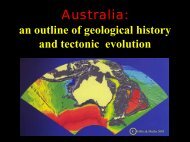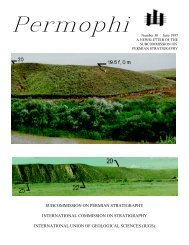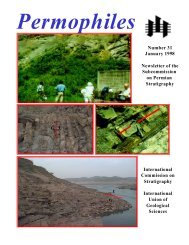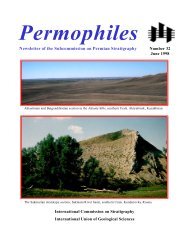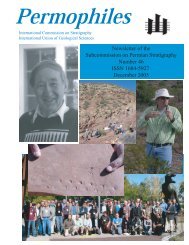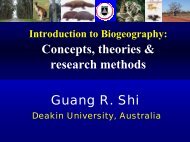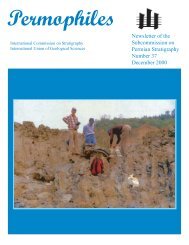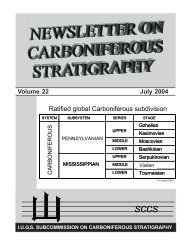Permophiles
Permophiles
Permophiles
You also want an ePaper? Increase the reach of your titles
YUMPU automatically turns print PDFs into web optimized ePapers that Google loves.
<strong>Permophiles</strong> Issue #39 2001Explanation of FiguresPenchiella barakarensis gen. et sp. nov. (Figures 1-3,5; BSIPSlide No.12675 )1. Proximal surface of megaspore in dry condition, x902. Photograph taken in wet condition to show dark colouredmesosporium, x903. A portion of dry megaspore enlarged to show furcate ornamentationover exosporium, x1375. Macerated megaspore showing exosporium disintegration andornamentation, x137Sethiaspora gondwanensis gen. et sp. nov. (Figures 4,6-9; BSIPSlide No.12676 )4. Proximal surface of megaspore in dry condition, x117a. Margin of megaspore is enlarged to show simple andbranched processes over exosporium, x2709. Mesosporium in wet condition showing trigonally arrangedcushions, x126crofti to primitive “Clarkina” sp. (Wardlaw and Mei, 1998).New material from the upper part of the Apache Mountainssection has yielded abundant examples of Clarkina postbitteriin a complete growth series. From a related section also in theApache Mountains a sample yielded abundant examples ofJinogondolella granti in a complete growth series. Thepresence of abundant material displaying a complete identifiablegrowth series clearly establishes the presence of these speciesin West Texas. That the species utilized in defining the conodontzonation for the proposed GSSP for the Guadalupian-Lopingian boundary in South China; that is, Jinogondolellagranti and Clarkina postbitteri (Jin et al., 2001), are presentalso in West Texas indicates that the Guadalupian-Lopingianboundary, or at least a position very close to it, is preserved inthe uppermost sediments of the Bell Canyon and AltudaFormations.New MexicoEditor’s Note: <strong>Permophiles</strong> does not constitute formal publicationof taxonomic names; it is an informal newsletter!ShelfGuadalupe MountainsTexasLatest Guadalupian-Earliest Lopingian ConodontFaunas from West TexasApache MountainsBruce R. WardlawU.S. Geological Survey, Reston, VA 20192 USALance L. LambertGeology Department, University of Texas, San Antonio, TX78249 USAMexico100 kmBasinDel Norte MountainsMerlynd K. NestellGeology Department, University of Texas, Arlington, TX 76019USAClarkina postbitteriLatest Guadalupian and earliest Lopingian conodont faunasfrom West Texas have been reported including the appearancesof Jinogondolella granti and Clarkina postbitteri (i.e., theAltuda Formation from the Bird Mine section, Del Norte Mountains;Wardlaw and Mei. 1998; and the Reef Trail Member of theBell Canyon Formation, Reef Trail section, Guadalupe Mountains;Wilde et al., 1999). These reports have been ignored (Meiet al., 1998) or questioned (Mei and Henderson, 2001). This noteis an abbreviated abstract of an upcoming paper that documentsthe occurrences of both Jinogondolella granti and Clarkinapostbitteri (now = C. postbitteri hongshuiensis) from WestTexas. The location of critical sections and examples of the twospecies are illustrated in Figure 1.Latest Guadalupian and potentially earliest Lopingianconodont faunas are found in the above mentioned Bird Mineand Reef Trail sections and in an additional section of the LamarLimestone Member of the Bell Canyon Formation in the ApacheMountains. A sample from the Bird Mine section shows acomplete morphological transition series from Jinogondolella31Jinogondolella grantiFigure 1. Location of sections and examples of Jinogondolellagranti and Clarkina postbitteri from West Texas. All thesections containing the latest Guadalupian-earliest Lopingianconodonts represent slope deposition around the margin of theDelaware Basin.



